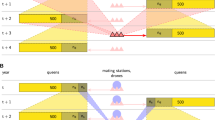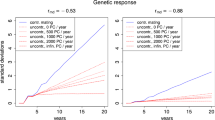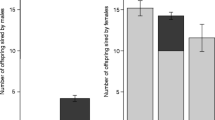Summary
Sex-linked effective population size (Ne) is derived for a variety of control population structures relevant to normal diploid and/or, more importantly, to haplo-diploid species. For equal sex ratio, it is shown that the control population structure which doubles autosomal effective population size trebles sex-linked effective size. For haplo-diploid species where the number of males exceeds the number of reproductive females, several different control structures are described, which tend to increase effective population size by about 1/3. These would be suitable for stock maintenance of honeybees. Directional selection programmes employing within-family selection would maintain most of the minimum drift/inbreeding properties of these control populations.
Similar content being viewed by others
References
Crow JF, Kimura M (1970) An introduction to population genetics theory. Harper and Row, New York
Falconer DS (1981) Introduction to quantitative genetics, 2nd edn. Longman, London New York
Gowe RW, Robertson A, Latter BDH (1959) Environment and poultry breeding problems. 5. The design of poultry control strains. Poult Sci 38:462–471
Hill WG (1972) Estimation of genetic change. 1. General theory and design of control populations. Anim Breed (Abstr) 40:1–15
Kaftanoglu O, Peng YS (1980a) A new syringe for semen storage and instrumental insemination of queen honeybees. J Apic Res 19:73–76
Kaftanoglu O, Peng YS (1980b) A washing technique for collection of honeybee semen. J Apic Res 19:205–211
Laidlaw HH (1979) Contemporary queen rearing. Dadant and Sons, Hamilton, Ill
Latter BDH (1959) Genetic sampling in a random mating population of constant size and sex ratio. Aust J Biol Sci 12:500–505
Moran C, Oldroyd BP (in preparation) Genetic improvement of honeybees in closed populations
Moran PAP, Watterson GA (1959) The genetic effects of family structure in natural populations. Aust J Biol Sci 12:1–15
Oldroyd BP, Moran C (1983) Heritability of worker characters in the honeybee (Apis mellifera). Aust J Biol Sci 36:323–332
Ollivier L (1973) Le calcul de l'effectif genetique des populations animales. Ann Genet Sel Anim 5:363–368
Page RE, Laidlaw HH (1982) Closed population honeybee breeding. 2. Comparative methods of stock maintenance and selective breeding. J Apic Res 21:38–44
Page RE, Marks RW (1982) The population genetics of sex determination in honeybees: random mating in closed populations. Heredity 48:263–270
Pollak E (1980) Effective population numbers and mean times to extinction in dioecious populations with overlapping generations. Math Biosci 52:1–25
Wright S (1933) Inbreeding and homozygosis. Proc Natl Acad Sci USA 19:411–420
Wright S (1939) Statistical genetics in relation to evolution. In: Actualites scientifiques et industrielles. Exposes de Biometrie et de la statistique biologique XIII, no. 802. Hermann et lie, Paris, pp 5–64
Wright S (1969) Evolution and the genetics of populations, vol 2. The theory of gene frequencies. University of Chicago Press, Chicago London, pp 204–220
Author information
Authors and Affiliations
Additional information
Communicated by J. S. F. Barker
Rights and permissions
About this article
Cite this article
Moran, C. Sex-linked effective population size in control populations, with particular reference to honeybees (Apis mellifera L.). Theoret. Appl. Genetics 67, 317–322 (1984). https://doi.org/10.1007/BF00272867
Received:
Issue Date:
DOI: https://doi.org/10.1007/BF00272867




